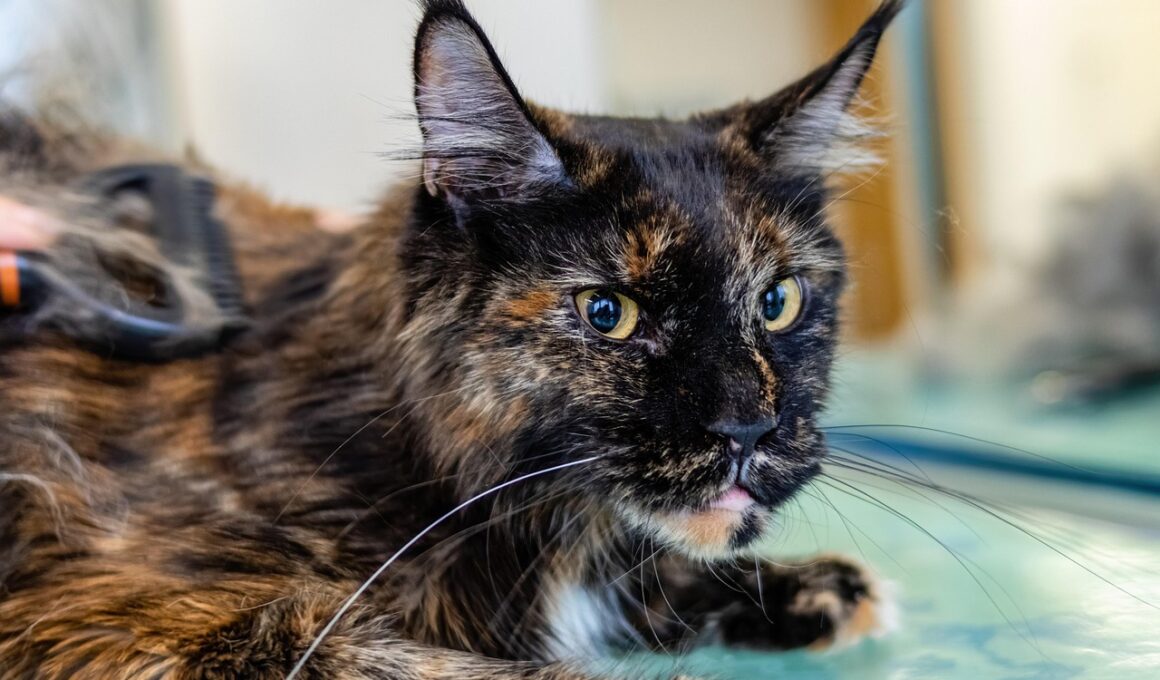Handling a Nervous Cat During Grooming
Grooming a cat can often be a challenging task, especially when dealing with a nervous feline. Understanding your cat’s body language is essential. Cats communicate their feelings predominantly through body signals. Signs such as flattened ears, a twitching tail, or hissing indicate discomfort. Knowing these signs can help you proceed cautiously. Cats that are nervous about grooming may need more time to acclimate. Begin by allowing them to explore grooming tools, such as brushes, by leaving them out for sniffing. Choosing the right environment is crucial as well; a quiet, familiar space is ideal. Keeping noise levels low can help them feel safe. Additionally, consider utilizing aromatherapy to create a soothing atmosphere. Calming scents like lavender may mitigate stress. Moreover, you should have treats on hand; rewarding your cat with a treat after each grooming session builds positive association. Slowly introducing the grooming process with short, gentle strokes can work wonders. Patience is key in these scenarios. Over time, your cat will likely become more relaxed about grooming. Consistent, gentle handling reinforces trust and creates a peaceful grooming routine.
When it comes to selecting the right grooming tools, each tool serves a unique purpose. For example, a fine-toothed comb is perfect for detangling, while a slicker brush effectively removes loose fur. Selecting a rubber brush can also be beneficial for cats with sensitive skin. Grooming sessions shouldn’t feel like a chore to your feline friend, so make it enjoyable! Regular practice creates comfort and confidence in your cat, making grooming less of a hurdle over time. Always check the tools before each session to ensure they’re in perfect condition. Dull edges can harm your cat or create additional stress. Having a steady approach requires being aware of your cat’s mood. Watch for those signs; if the cat shows distress, take a break. Mixing in games or interactions can aid in building your cat’s trust. Switching between brief grooming intervals and playtime keeps things light, reducing anxiety. If your cat expresses displeasure, don’t push through the process. Instead, stop, calmly set the tools aside, and return later. Over time, your cat will adapt to your routine.
Creating a Calm Environment
Establishing a calming grooming environment is crucial for a nervous cat. Create a serene space by eliminating distractions. Dim the lights and turn off loud electronics. Play tranquil music or white noise to drown out unsettling sounds. Make sure to lay out a comfortable surface, like a soft blanket or grooming mat, that your cat associates with relaxation. Consider using pheromone sprays that mimic the calm scent of nursing cats. This can go a long way in alleviating stress. Experiment with different locations; some cats prefer being groomed in a quiet corner, while others need to be near their favorite window. Being flexible with location can help accommodate your cat’s comfort. Introduce a calming routine before grooming to help signal that it’s time. You might start with gentle petting, following the same pattern each time. Additionally, you might try grooming at a specific time of day that the cat seems most relaxed. Building a routine helps set expectations and enhances trust as your cat learns what will happen next.
While grooming, employ gentle techniques to ease your cat’s nervousness. Slow, soothing strokes are more comforting than abrupt motions. Begin with the areas the cat enjoys the most, typically around the face and head. Gradually work your way to the less-favored areas, like the back and tail, while watching for signs of distress. Keep an eye on your cat’s reaction and adjust accordingly. Pause frequently, giving your pet the chance to breathe without feeling overwhelmed. Returning to your comfort zones for reprieve is essential. Additionally, maintain a calm demeanor; speaking softly and reassuringly throughout the grooming process can create a sense of security. You might also incorporate a familiar toy as a distraction; this can grab their attention and alleviate stress. As grooming progresses and trust builds, you’ll find it increasingly easier to work through those sensitive areas. Always remember to reward your cat’s bravery with praise or treats. Reinforcement nurtures a positive experience for future grooming sessions, establishing a reliable handling pattern.
Using Treats Wisely
The strategic use of treats can elevate grooming sessions to enjoyable experiences. Cats possess strong associative memory skills, which means enjoying treats during these sessions can positively reinforce the activity. Be mindful to select healthy treats that are safe for feline consumption. High-quality, soft options work well as they’re easy to chew and swallow. Presenting treats during the grooming process, especially after completing a segment, shows your cat that good things happen. This encourages them to cooperate instead of resist during rest of the grooming. However, don’t bombard your cat with treats all at once. Instead, administer small amounts over time, allowing the cat to savor. Additionally, use interactive toys that dispense treats to attract their attention while grooming. This distraction can aid in keeping your cat engaged. Gradually, as they associate grooming with positivity and rewards, you’ll witness a shift in your cat’s behavior. It’s fascinating how a simple reward can transform their experience from a stressful ordeal to a pleasant routine that strengthens your bond.
Monitoring your cat’s behavior during grooming is pivotal to a positive outcome. Subtle changes in their body language can signify discomfort or anxiety. Recognizing these signs enables you to pause and adapt methods accordingly. If your cat hisses or tries to escape, cease grooming immediately. Respecting your animal’s limits fosters trust and safety. Reapproaching the situation when the cat is calm signals understanding. Hosting grooming sessions thereafter can be adjusted to cater to temperament changes. Another strategy is to secure a partner to assist you; their presence might comfort your cat during grooming. Having someone that gently holds the cat can provide both stability and care while you groom. Ensure that the person is also gentle and kind. Furthermore, consider discussing strategies with your veterinarian or pet groomer, as they can provide tailored advice. Each cat is unique, so gathering varied inputs is beneficial. Establishing a regime that suits your nervous cat can create a lasting positive atmosphere, where grooming becomes a routine that promotes bonding and trust.
Conclusion
Successfully handling a nervous cat during grooming requires patience, understanding, and dedication. Recognizing their signals lays the foundation for trust and security. Create a safe and comforting environment by eliminating distractions which provoke anxiety. Employ gentle grooming techniques that move smoothly and consistently without sudden jerks. Introducing tasty treats serves several purposes; it helps establish a positive association with the grooming process. Additionally, monitoring your cat’s reactions helps guide the grooming routine, allowing for better adaptability. Ensure to adjust your approach based on their individual preferences and comfort levels. In time, with consistent practice, your cat will likely grow to appreciate these grooming sessions. Building a steady routine around grooming fosters a sense of predictability, contributing to a harmonious relationship between you and your feline companion. Lastly, never hesitate to seek advice from professionals if needed; they can offer invaluable guidance tailored specifically for your pet. As you work together, you’ll cultivate an environment of care, love, and respect, making grooming an enjoyable part of your shared lives.



